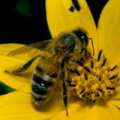 根據美國國家研究院一份最新報告,北美地區的蜜蜂、蝙蝠及其他重要傳粉動物,數量有減少的情況,這對穀物及其他植物的繁衍極為不利。報告並指出野生傳粉者數量減少已是事實,倘若情況加劇將危及生態與農作生產。
根據美國國家研究院一份最新報告,北美地區的蜜蜂、蝙蝠及其他重要傳粉動物,數量有減少的情況,這對穀物及其他植物的繁衍極為不利。報告並指出野生傳粉者數量減少已是事實,倘若情況加劇將危及生態與農作生產。
衛生研究院主席、同時也是伊利諾大學香檳分校昆蟲學家貝倫堡(May Berenbaum)表示:「傳粉動物數量減少聽起來不是個華麗煽動的議題,事實上,這個問題不僅涉及全球化環境轉變,也絕對有潛力改變陸地生態系的樣貌和結構。」
傳粉動物藉著遞送花粉,使開花植物受精過程得以完成。四分之三的開花植物——包括大部分農作物和提供纖維、製藥和燃料的植物——都依賴傳粉動物才能進行有性生殖。
國家研究院憂慮地提出警告,目前北美傳粉動物族群資料實在少得可憐,政府應該更關注這個議題。儘管田野資料並不連貫,但委員會表示,充分證據顯示北美許多蝴蝶、蝙蝠、蜂鳥,和一些野外蜂種的族群規模,都處於長期下滑趨勢。特別是蜜蜂,超過90種商業化種植作物靠蜜蜂傳粉,對美國農業影響甚鉅,而完成農作物傳粉所需的蜜蜂數量之龐大,恐怕超乎想像。
根據加州一份數據,55萬英畝杏仁樹需要140萬群蜜蜂傳粉;而美國自1980年代受外來種璊類入侵,至今蜜蜂最少已減少30%。黃蜂同樣遭受外來昆蟲威脅而減少。許多傳粉動物因棲地萎縮影響而減少,特別是原生蝙蝠所受影響最大。
不只美國,全球都面臨傳粉動物銳減的窘境;歐洲研究人員累積更多資訊,證實傳粉動物不僅減少,有些甚至已經絕種。這份報告建議美國政府和加拿大、墨西哥合作,形成一道監控傳粉動物的長期網路,並立即著手建立基礎資料,提供後續觀測結果一座可供比較差異的研究平台。
Bees, bats and other vital pollinators are declining across North America, placing crops and other plants at risk, according to a new report by the National Research Council. The report finds that shortages of pollinators already exist and warns that continued decreases in wild populations could disrupt ecosystems and agricultural production.
"Despite its apparent lack of marquee appeal, a decline in pollinator populations is one form of global change that actually has credible potential to alter the shape and structure of terrestrial ecosystems," said committee chair May Berenbaum an entomologist at the University of Illinois , Urbana-Champaign.
Pollinators are vital to the environment as they spread pollen, enabling plant fertilization to occur. Three-quarters of all flowering plants - including most food crops and some that provide fiber, drugs, and fuel - rely on pollinators for fertilization.
The committee cautioned that there is little or no population data for many North American pollinators and urged increased monitoring efforts.But there is ample evidence that long-term population trends for some key North American pollinators, including butterflies, bats, hummingbirds and several wild bee species are "demonstrably downward," the committee said.
The report sounds a specific warning for the honeybee, which are vital to U.S. agriculture, pollinating more than 90 commercially grown crops. It can take a massive amount of bees to ensure a crop is suitably pollinated.
For example, it takes about 1.4 million colonies of honeybees to pollinate 550,000 acres of almond trees in California. U.S. honeybee populations have declined at least 30 percent since the 1980s, when a non-native parasitic mite was introduced. Like the honeybee, the bumblebee has been hurt by the introduction of a non-native parasite, the committee said, and many pollinator declines are associated with habitat loss - particularly native bat populations.
The committee noted that its findings reflect a global decrease in pollinators. In Europe, where much more data has been gathered on pollinators, researchers have definitively documented declines and even extinctions. The report recommends the United States work closely with Canada and Mexico to form a network of long-term monitoring projects as well as a rapid, one-time survey should be conducted to establish baseline data to which future assessments can be compared.






